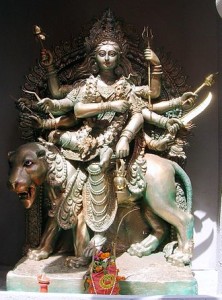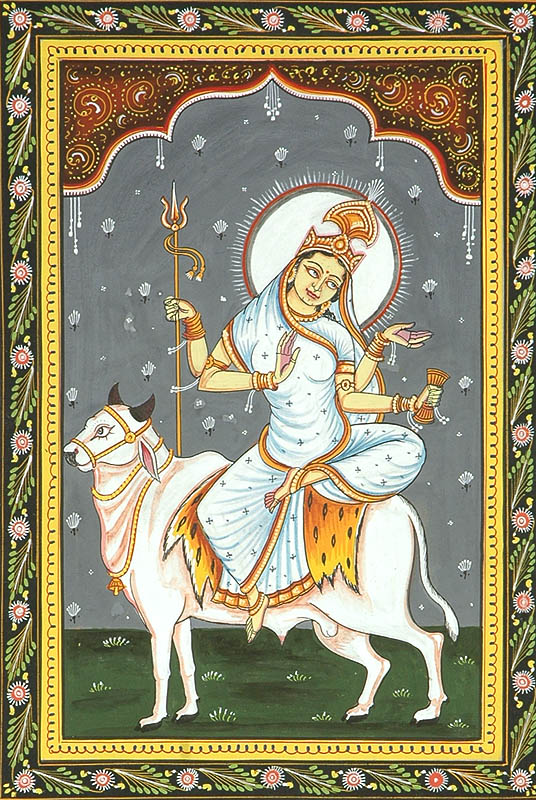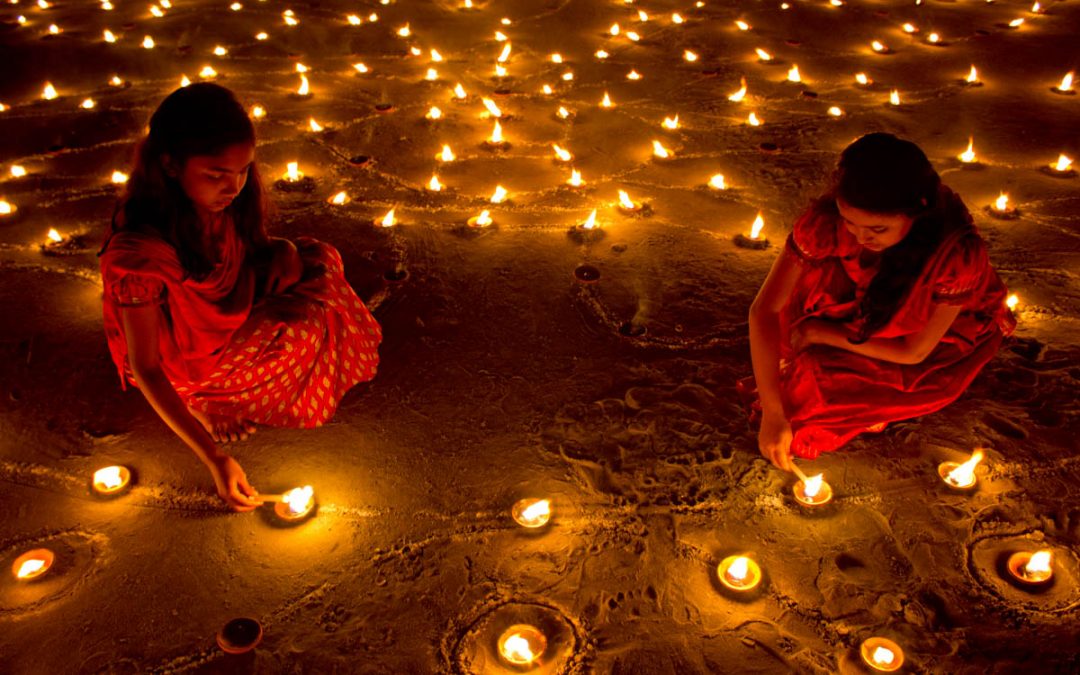
by Somya Devi | Oct 24, 2019 | Astrology, Conjunctions, Holy Days, Planets Changing Signs
The Sun and Moon will join at 10° sidereal Libra this Sunday night, October 24th, at 8:39 pm PDT. This Dark Moon night commemorates the Hindu holiday of Diwali, the festival of lights. October 27th will actually be the third but main night of celebration of this festival, which begins on Dhanteras on October 25th.
Libra cycle
The New Moon in Libra will begin a Libra cycle, compelling us to find balance, harmony, beauty, and compromise. Venus will have just left his own sign of Libra, a couple of hours before the New Moon, but has been strong there the last several weeks and during most of the Amavasya dark Moon phase leading up to the exact New Moon moment.
One thing to note about the Libra cycle is that the Sun is considered neecha or naturally debilitated there, so self-care becomes especially important during a Libra cycle. Since the Sun relates to our sense of strength and vitality, and Libra is the sign of compromising (or over-compromising) with others, it is possible that our own strength becomes diminished as we elevate the level of energy and attention we give to those around us. Caring for others doesn’t necessarily translate to depleted health, but it can when we overemphasize the outer world and others to the point of neglecting our own self-care.
This is a very important time of year to nourish ourselves, and our inner light, as the outer light is descending. At the beginning of this cycle, set an intention for a mindful self-care routine this month. Light some candles (or turn on your electronic ones) for Diwali on the Dark Moon night, and if possible, take some time each day to offer yourself some time to nourish and honor your personal light. Self-care practices can include yoga, meditation, chanting, art, or self-abhyangha (oil massage). You can also make some herbal tea to nourish yourself during this vata (cold and dry) season.
Swati Nakshatra
This New Moon joins the Sun in Swati nakshatra, a nakshatra that is also known to add to vata conditions, as it gives the power to scatter like the wind, so be aware of restlessness this Dark Moon night. It is ruled by Lord Vayu, wind embodied, and is symbolized by a young plant blowing in the wind, both flexible and strong amidst it. It can be translated as the “priest” or the “sword” and carries hidden spiritual potential from its association with Rahu. The male buffalo is the animal symbol for Swati nakshatra.
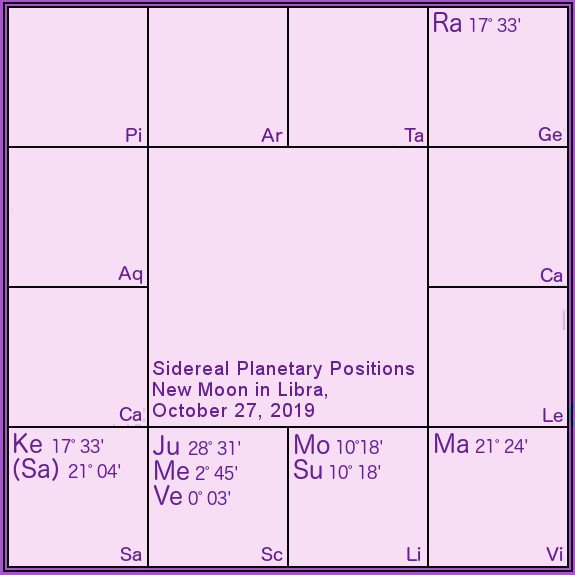
Venus, Jupiter and Mercury
These three benefic planets will be traveling together in sidereal Scorpio from October 26th through November 4th, when Jupiter transits into Sagittarius. The conjunction of these three planets creates a Sarasvati yoga during certain times of day, which could offer auspicious muhurtas (moments) for initiating artistic, educational or spiritual activities. If you were born with a Sarasvati yoga in your natal chart, you may find it more activated during these times.
Jupiter in Sagittarius
On November 4th, we will experience a major movement in the cosmos, as Jupiter transits from Scorpio into Sagittarius. Because the outer planets move slower, they spend longer in each sign, so this transit is important because it will take effect for over a year while Jupiter travels through his own sign. Generally that brings strength to a planet, but with the current conjunction with Saturn and Ketu, also in Sagittarius, we could see an intensification of strange and radical ideologies vying for their place on the world stage.
Dhanteras and Diwali
On the new Moon of the Hindu month of Ashwin (this month), we celebrate Diwali, the festival of lights. The festival begins this year on Friday, October 25th (North America), on the 13th waning Moon phase of the previous cycle. This day is known as Dhanteras, or Dhanvantari Tryodashi, the celebration of the birth of Lord Dhanvantari, the father of Ayurvedic medicine. If you practice any healing tradition, especially Ayurveda, this is a good day to give thanks and call in auspicious blessings to your healing path or practice.

Diwali is strongly associated with the Goddess Laxmi, and is a powerful time to connect with her, calling in her blessings for both material and spiritual prosperity. Dhanteras commemorates the day that Lakshmi emerged from the milk ocean in Vedic lore. In India, it is customary to purchase metals on this day — anything from jewelry to new statues to kitchenware (excluding iron), especially silver and gold — as a part of celebrating Lakshmi and calling in more prosperity. The metals can then be offered to your altar and will absorb and amplify the benefits of worship performed over the few days of Diwali.
We celebrate Diwali while the days are getting noticeably shorter and darker, and it is a time to invite more light into our lives, our hearts, and our world. This festival celebrates the victory of light over darkness, which is something to rejoice in and have faith in, even if we can’t outwardly observe it sometimes. Creating positive vibrations internally is the best way to begin growing and spreading them externally.
Diwali also commemorates Lord Ram’s and Sita’s return from exile after fourteen years (a story from the Ramayana). Lord Ram embodies the highest qualities of dharma, devotion, compassion, courage, and leadership. Diwali is also the start of a new lunar cycle, so it’s a great time to go within and summon these qualities to awaken and live through you.
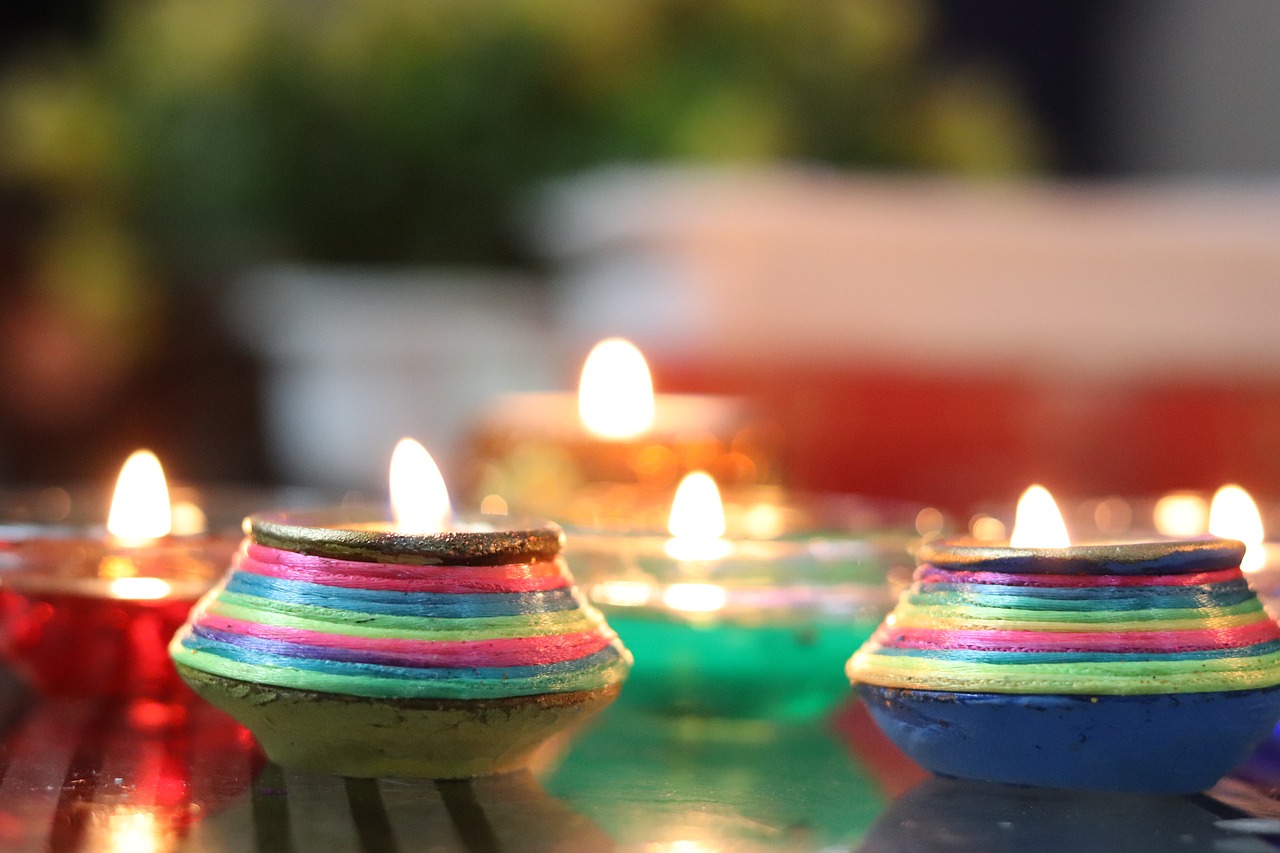 Diwali (also seen as Divali, Deepawali or Deepavali) comes from the Sanskrit words deepa (light) and avali (row). It is traditional to light candles throughout Diwali (opt for electronic tea lights if you’re in a fire danger zone!), inviting the highest light into our homes and lives. The candles are lit to remind us of the inner divine light in us all. Though one flame can be used to light many others, it is not diminished by sharing its power of illumination. We can pray for the peace and happiness of all beings, and each one’s awareness of their inner light.
Diwali (also seen as Divali, Deepawali or Deepavali) comes from the Sanskrit words deepa (light) and avali (row). It is traditional to light candles throughout Diwali (opt for electronic tea lights if you’re in a fire danger zone!), inviting the highest light into our homes and lives. The candles are lit to remind us of the inner divine light in us all. Though one flame can be used to light many others, it is not diminished by sharing its power of illumination. We can pray for the peace and happiness of all beings, and each one’s awareness of their inner light.
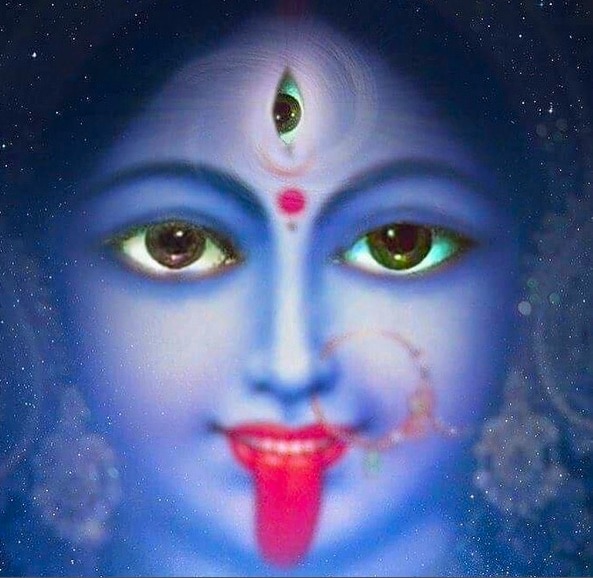
by Somya Devi | Sep 27, 2019 | Astrology, Events, Holy Days
Maha Navaratri 2019 is upon us! In this important Hindu holiday, we celebrate the Goddess through “the great nine nights” (nav = nine, ratri = night). This festival will run from September 29th through October 8th, the first ten days of this new lunar cycle. Goddess, Devi, Shakti, Durga, Divine Mother—the many names and forms all represent the dynamic and fluid feminine power that enlivens all of existence.
She is the creatrix, the warrioress, the nurturer, the purifyer, the protector. While she’s in the innocent and fertile maiden so is she the wise and learned crone. Both the nurturing mother, and the one who gives “tough love.” The impassioned lover, the devoted bhakta, the disciplined yogini. We see Goddess appear through us in innumerable manifestations. Through her many forms she teaches us and offers us countless blessings–love, compassion, courage, learning, discipline, surrender, success, enlightenment, and bliss. This festival is a time for celebrating the supreme feminine power in all her glory, and the many blessings she bestows upon us.
As with most Hindu celebrations, this festival correlates with the lunar calendar, and thus begins on the first day of the waxing Moon after the New Moon of September 28th. The celebration is through the “nine nights” of September 29th through October 7th, and into the tenth morning known as Vijayadashami, “the day of victory.” Worship during Navaratri is most generally dedicated to Goddess in the form of Durga, the demon-slayer, but there is much nuance and variation to practice and forms of celebration throughout India. Above all, Navaratri is a community celebration of the Divine Mother, and the love, abundance and protection she gives.
There are many Navaratri celebrations throughout the year, but the fall-time Navaratri is the most widely celebrated, and is thus called Maha Navaratri – “the great nine nights”. It correlates with the time of the harvest, a time to give thanks for the abundance of the year’s work. Grains and crops are often offered to Devi as part of the celebrations. Ritualistic worship (puja) typically occurs in homes and temples throughout the nine nights and into the tenth morning of celebration.
The Many Forms of Goddess
Durga-Lakshmi-Sarasvati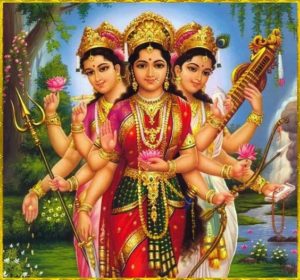
In Kerala and other places in India, the first three nights of worship are dedicated to Durga (the invincible), the next three to Lakshmi (Goddess of prosperity), and the final three to Sarasvati (Goddess of learning). Durga, also celebrated as her incarnation of Kali, helps us to destroy and remove the negative tendencies in our minds and hearts, freeing us from the obstructions to our spiritual and material pursuits. Lakshmi helps us to cultivate positive qualities like compassion and devotion, and leads us towards both spiritual and material prosperity. Sarasvati assists us in attaining knowledge and wisdom, through the illumination of our consciousness. She aids in awakening sattva, the quality of purity, and the flow of prana, the vital breath. After removing inner and outer obstacles and cultivating prosperity through virtuous qualities, our devotion, service, and practice help us to attain a state of peace, bliss, and oneness.
Sarasvati-Lakshmi-Kali/Durga
In the Kali Kula (Kali school of worship) in northeastern India, Sarasvati is worshiped on the first three nights, followed by Lakshmi on the next and then Kali/Durga on the last three. Sarasvati, Lakshmi, and Kali/Durga (Kali emerged from Durga) are also known as the consorts of Brahma, Vishnu, and Shiva. The Goddesses, therefore, provide the shakti to the cosmic processes of creation, preservation, and death (transformation), similar to their male counterparts. Consequently, worship in this manner is dedicated to the cycles of life and Mother nature, through birth, then sustenance, then death. Death is not a complete stop, but allows for the regeneration of energy into a new cycle once again.
9 Forms of Durga
Throughout India, the nine nights of Navaratri are often dedicated to 9 different incarnations of Durga, allowing the worship of many different aspects of Shakti in a gradual evolution. You can read the stories and significance of these 9 goddesses here, or a more a brief introduction, here:
“Daughter of the mountain”; creative energy, muladhara (root chakra), awakening; Awaken your connection with Goddess today or initiate a new venture, calling on Shailputri for new beginnings.
The ascetic; tapas, discipline, devotion, strength, wisdom, creative abundance; Good day for fasting and meditation, connection with svadhistana (sacral chakra).
Warrioress; protection, courage, grace, manipura (solar plexus); Destroy your internal obstacles by offering them to Chandraghanta.
Creatrix of the “cosmic egg”; strength, health, happiness, success, relationships; Connect with the vital Sun energy and the anahata (heart chakra) today.
“Mother of Skanda/Kartikeya”; motherly love, nourishment, protection, purity; Call on divine truth through the vishuddha (throat chakra), invoking Skandamata to lead you towards victory.
Warrioress who destroyed Mahishasura (the buffalo demon); victory, devotion, strength, removing obstacles; Meditate on these qualities of Goddess through the ajna chakra (third-eye) today.
“Dark/black night,” representing a fierce form of Durga/Kali; darkness, death, surrender, dissolution of pain; Connecting with the sahasrara (crown chakra), remember that Divine Mother offers love, compassion, and many blessings even in hard times. Even in the midst of apparent darkness, and helps us to go beyond the boundaries of the material body-mind and connect with spirit.
“Great white goddess”; detachment, purification, renewal, protection, virtue; Through detachment and devotion, we emerge purified, shining and radiant after surrendering in the dark night. Rejuvenative herbs and foods are good today.
Goddess of “siddhis”; magical, spiritual or mystic powers and blessings, fulfillment of desires, devotion, divine union; Invite Goddess to reveal her presence to you everywhere and in every moment.
Personal Practice Ideas for Navaratri
If possible, it is great to reduce our workload and gather with community at local temples or places of worship. We can also create a little time and space at home and conduct some personal practices to celebrate Goddess energy. Dive into your own heart to connect with the inner Goddess in the ways that resonate most with you! Here are some ideas to do at home or with a group throughout the nine nights of Navaratri:
Altar
Create a sacred space, a Durga altar, or a Goddess altar. Even if you already have one, you can refresh it in some way or rearrange it specifically for Navaratri. Include images or statues of the Goddess(es) you have a relationship with. This could be according to one of the groups of forms above.
Invocation
Even if you don’t have much time, dedicate at least a few minutes each day to connecting with the Divine Mother in front of your altar, calling her energy into your life and being.
Journal
Write in your journal about what qualities of Goddess you perceive and connect with. What aspects would you like to strengthen or to cultivate more deeply? Write any and all prayers and offer them to the form of Goddess that appeals to you.
Light
Offer light to illuminate Goddess’s power, helping her to shine more brightly into the world and your life. You can light a candle by the altar and keep it burning when you’re at home. You can even keep an electronic tealight on symbolically when you are away.
Flowers/Grains
Offer flowers or grains (even a small dish of dried rice) to celebrate Devi in the form of mother nature, fertility, the abundance of the harvest, and the cycle of life.
Offerings
Offer incense, bells, water, or food if you feel called, by placing it on the altar, or mentally offering it to Goddess throughout the day. You can also offer something symbolic of your own work or practice, whatever you have been cultivating for harvest through the year. In offering this you surrender the fruits of your efforts to the Divine Mother.
Fasting
Some people choose to fast in some variation, if this is something you have practiced before. This might include fasting during the day, fasting with only milk or fruit, or abstaining from alcohol and non-vegetarian foods during Navaratri.
Chanting
Chanting the Devi Mahatmyam, a verse to the Goddess, is a common practice during the nine-night festival. You can also chant another Goddess mantra or songs that are special to you and your relationship with Devi.
Jai Ma Durga!
Personal Vedic Astrology readings and forecasts are available Here.
Did you like Maha Navaratri 2019? Please Like, Comment and Share!
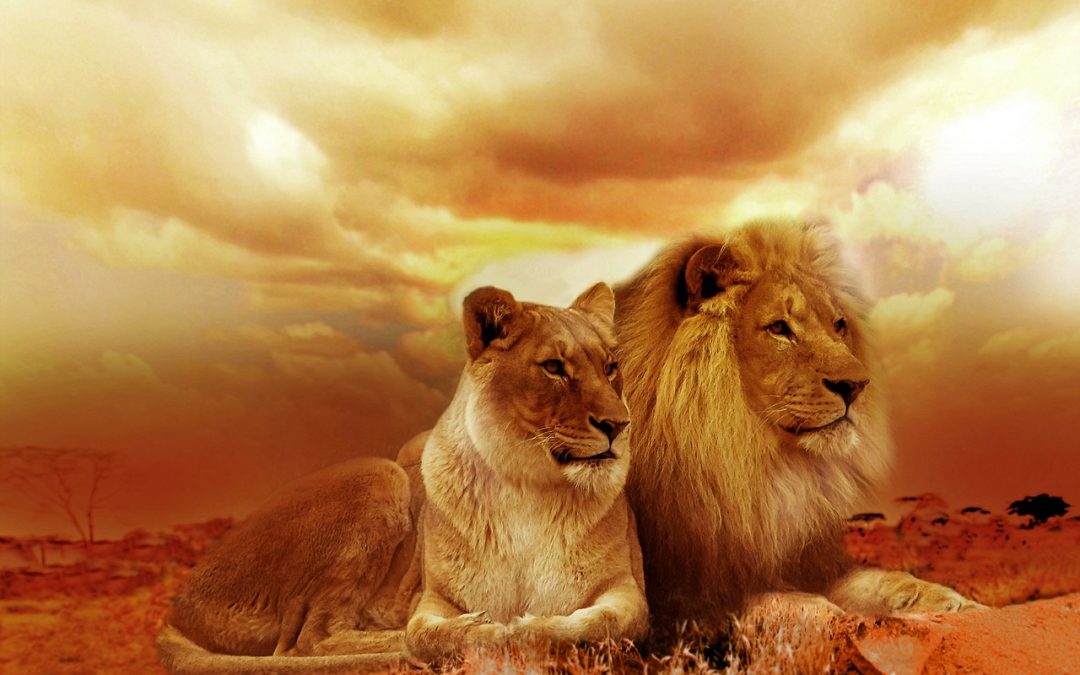
by Somya Devi | Aug 29, 2019 | Astrology, Conjunctions, Events, Holy Days, Planets Changing Signs, Retrograde
Leo New Moon
The Moon is now in the amavasya new Moon phase, waning to total darkness to begin a new lunar cycle tonight at 3:37 am PDT, on August 30th. The Sun and Moon join in sidereal Leo, with Venus, Mars and Mercury all nearby. Sun, Moon and Mercury align with the Vedic nakshatra Magha, “the mighty one,” while Mars and Venus are in Purva Phalguni.
A Leo cycle can bring us in touch with our own inner strength, as Leo is ruled by the Sun and is in essence the royal seat in the zodiac. The Sun’s hot rays work to burn off our impurities, moving us towards our own sattvic nature as is the nature of the Sun. With Mars, Mercury, and Venus all combust as we begin this cycle, Sun is the predominant force in the sky and his message reigns supreme.
His message may be telling you to step into your power and take responsibility over your “dominion.” It could be showing you where you’ve had enough — enough fighting, lusting, or intellectualizing — and need to align with the higher power within. A less intelligent outcome could be a greedy grasping for power, so watch that you pay attention to how you are wielding your energy.
Magha
Magha nakshatra is symbolized by the throne and spans the first 13°20’ of sidereal Leo. We can connect with the inner king of queen from here, and consider the ethics that come with regality. Magha is ruled by the Pitris, the ancestor deities, which indicates this is an important time to connect with your past lineage. The planetary ruler here is Ketu, which also brings in ties to the past and the subconscious. On this dark Moon night, open yourself to dive within and see if there is any inherited karma that is speaking to you or influencing your life now.
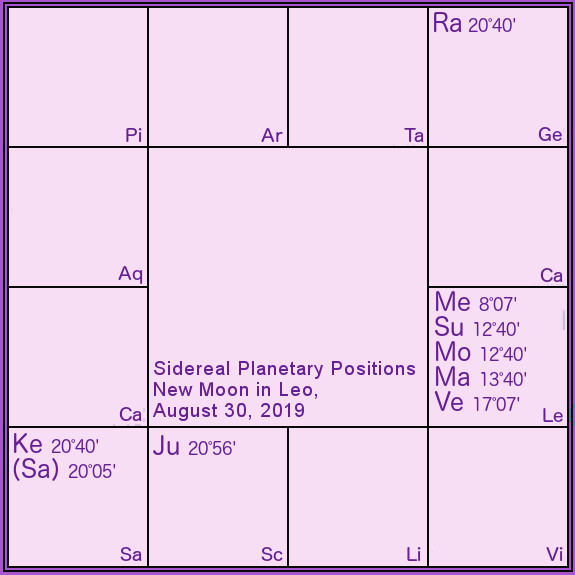
Combust Planets, Wars, & Debilitation
Mars is highly combust — one degree away from the Sun and Moon, while Venus is still slightly combust, within five degrees, and Mercury is within 4. This makes it a challenging time for achieving things ruled by these planets, so it’s not the most auspicious day for beginning new ventures in battles, love or learning.
Mars will be combust within 3 degrees of the Sun from August 24th through September 11th. From September 2-4 Mars and Mercury will go through a planetary war, while being combust at the same time (Mars being exact with the Sun on September 2nd). Again, not the most auspicious days to begin Mars- or Mercury-ruled projects. On September 9th Venus enters Virgo, his sign of debilitation. With Venus here the intellect rules over the desire-body, which can add a scrutinizing or business-like attitude to your romantic endeavors. Mercury and Venus enter a planetary war between September 11th and 15th.
Saturn & Ketu
Saturn and Ketu are coming closer and closer once again, for their third exact conjunction of this year on September 15th (two days after the next full Moon). A few days after that, Saturn will station and go direct on September 18th, while Ketu will continue in his ever-retrograde motion, and the two will finally begin to separate. The last six months may have brought particular challenges in the area of life shown by Sagittarius in your natal chart, or affected you deeply if you have Moon or other prominent placements there.
Ganesh Chaturthi
Jai Ganesha, creator and remover of obstacles! Ganesh Chaturthi will be celebrated on September 2nd, the 4th (chaturthi) waxing Moon phase (tithi) of this lunar cycle. This is an auspicious time to call on the elephant God (if you know him) to help clear a path in your life. Lord Ganesha is also associated with the planet Ketu, the ruler of Magha, where this lunar cycle begins. On Ganesh Chaturthi we can celebrate him through puja and prayer, and it is often customary to build a statue (out of natural clay), for our worship, and then release him into a body of water on the tenth day of prayer.
Personal readings are available and will help to explain how all of these alignments affect your chart and life in particular.
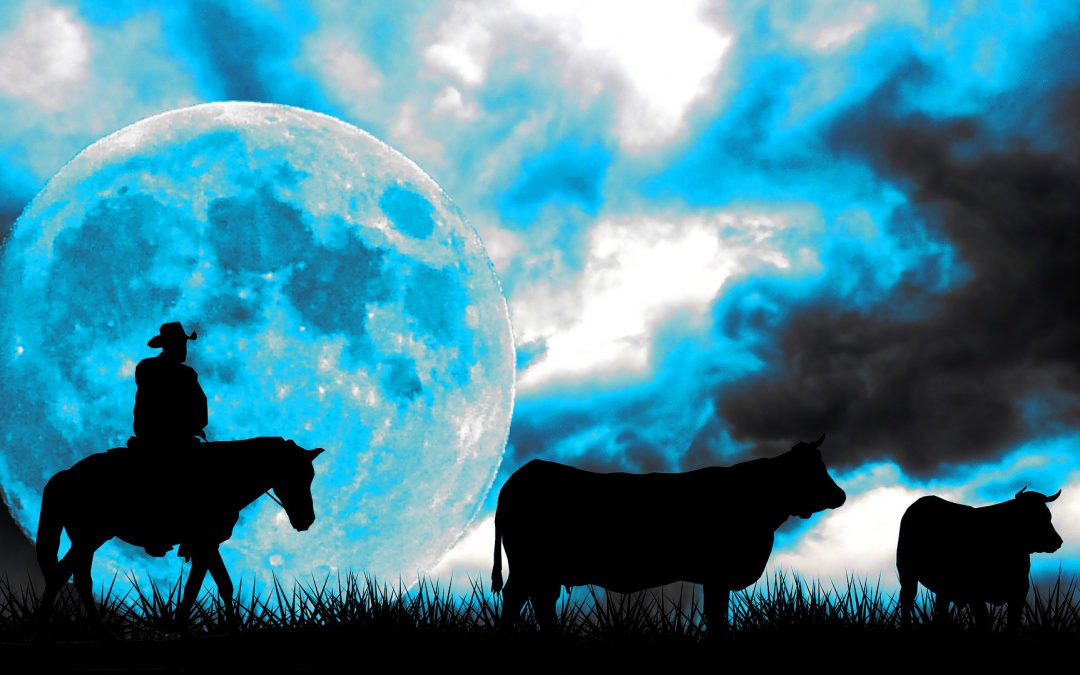
by Somya Devi | Jul 26, 2019 | Astrology, Conjunctions, Planets Changing Signs, Retrograde
The Sun and Moon are getting closer and closer as we head towards a Dark Moon night this coming Wednesday. The New Moon in sidereal Cancer will be exact on July 31st at 8:12 pm PDT. This completes the previous lunar cycle which brought on the eclipses that affected many people in deep ways, especially those running dashas of Rahu or Ketu.
Cancer
The Cancer cycle could be a chance to cool down a little and come back into the heart after the heady and philosophical cycle of Gemini-Sag, with all the added eclipse energy. Cancer is the Moon’s sign, the sign of the Divine Mother and her nourishing waters. Spend time in a body of water this month, and connect with your own internal waters (feelings!) around this New Moon. Cancer is the fourth sign naturally, relating to the heart and the breasts, and is feminine or yin, helping us to direct our energy inwards.
Pushya Nakshatra
Within Cancer, the Sun and Moon are joining in the Vedic nakshatra called Pushya, meaning “the nourisher.” Symbolized by the udder of a cow, this star-sign gives a sense of abundance and sustenance. It can elicit a strong sense of family and responsibility, relating to both the divine mother and the divine father. Its deity is Brihaspati, a form of Jupiter who showed generosity and unconditional fatherly love in the story of how he adopted Mercury (a love child between his wife and the Moon). Fertility is strong under this star, and could be throughout this Moon cycle.
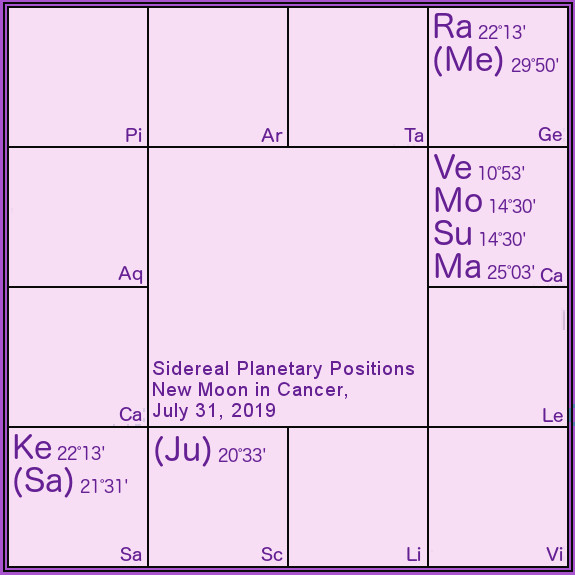
Mars Debilitated, Venus Combust
Mars is still traveling in Cancer, his sign of debilitation, for another week until he enters Leo on August 8th. Mars-ruled folks may feel their usual fight and fire is diminished, or that they’re needing more comfort and cuddling than normally.
Venus is also transiting through Cancer. He is already traveling fairly close to the Sun, but he’ll enter the highly combust zone (within 3 degrees), on August 3rd. With Venus so close to the Sun, we may find some of our worldly pleasurable pursuits feeling “burned up” by the purifying power of Surya. Relationships could be under a lot of pressure, or it may just be so hot where you are that it’s hard to enjoy anything. Venus reaches total combustion when he aligns with the Sun on August 14th, and won’t leave the 3-degree proximity zone until August 24th. (Looking at a 6-degree orb, Venus won’t leave combustion until September 4th.)
Jupiter Turning Direct
After several months, Jupiter is finally slowing down in his retrograde journey back through Scorpio, and will station and turn direct on August 11th. As he begins his journey forward once again, you’ll notice affects the most directly on the areas of life ruled by Jupiter in your chart, and depending on the unique placement of planets for you. In a general sense, we may notice things changing directions somewhat in the broader ideological field, as we have had a period of retrospection over principles and beliefs for the past several months.
Kala Sarpa Cycles
This New Moon finds all the planets in between the two nodes, on one side of the sky, creating a Kala Sarpa alignment. We’ll come under this alignment for half the month from now through December. When the Moon is on the same side of the nodal axis as the other planets, Kala Sarpa is on, and when he transits from Capricorn through Taurus, it is off. This can intensify the effects of the nodes, especially for those who have prominent nodal placements in the natal chart, or are running cycles of either Rahu or Ketu, bringing shadow work and intensity to the surface.
Mercury Turning Direct
Mercury is completely stationary at the time of this New Moon, turning “direct” less than an hour after the Sun-Moon conjunction. For those of you who have felt the Mercury Retrograde effects strongly this month, you can breathe a sigh of relief!
The next full Moon is on August 14th-15th.
This is a great time to have a personal reading– either an Initial Reading if this is your first time working with me, or an Eclipse Reading, if we have had a previous session, can help you to integrate the lessons that arose during the eclipse cycle.

by Somya Devi | Jun 3, 2019 | Uncategorized
Today begins the Taurus Moon cycle for this year, with Sun and Moon aligning exactly in sidereal Taurus early this morning (June 3rd) at 3:02 am PDT. In the fertile earth sign of Taurus, ruled by Venus, this dark Moon is inspired and uplifted in his sign of exaltation, while opposite a bright and graceful Jupiter.
Taurus Cycle
Taurus is the feminine earth sign ruled by the planet Venus. During the Taurus cycle, we may be more inspired to connect with the earth and the earthly elements around us. This is a good time for meditation with crystals and herbs, and utilizing gemstones and sweet juicy fruits as part of your offerings or remedies.
The dark Moon time is a good opportunity to hit the reset button each month. There may have been a lot of tensions building up throughout May due to Rahu and Mars together in Gemini, and the few days around the New Moon are a good time to cleanse and start a new cycle afresh. Sadhana will be important this month as well, as we are approaching an eclipse cycle in July.
Rohini
This Taurus cycle begins with Sun and Moon in Rohini nakshatra, “the reddish one.” The Moon’s nakshatra of exaltation, Rohini was said to be the favorite of the 27 “wives” he visited each month. There is a warm, nourishing, fertile energy here, ripe for beginnings of all sorts. The animal symbol of the male serpent also elicits sexual energy, while the symbol of the ox-cart relates to abundance through commerce.
Rahu and Mars
The two most aggressive planets are currently approaching each other in sidereal Gemini, as Mars makes his way forward and Rahu steadily creeps back through the degrees of this rashi. The last month may have brought up a lot of tense and aggressive communication, with a lot of harsh language in particular. This may be tempered now by Gemini’s ruler, Mercury, having joined the two malefics on June 2nd… But keep awareness of this conjunction over the next three weeks, especially on June 14th when Mars and Rahu come into exact alignment.
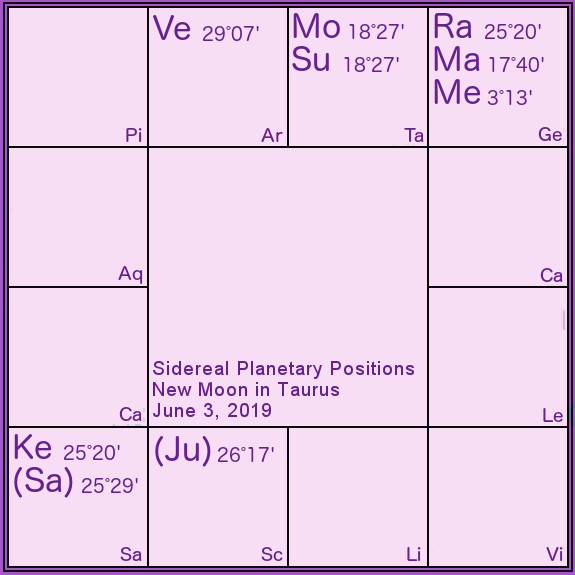
Eclipse Energy Building
We are now one month, one Moon cycle away from this summer’s eclipses. The first will be a Total Solar eclipse on July second, on the new Moon, with a partial lunar eclipse to follow on the full Moon of July 16th. Eclipse energy can usually be felt starting 2-4 weeks before the first eclipse of a set, so we may be experience the disruption already.
Eclipses are the times when the shadow grahas, Rahu and Ketu, become visible, and likewise our internal shadows begin to show themselves as well. Whatever areas of your life are located in Gemini and Sagittarius, this is where you are experiencing the nodal transit for a year-and-a-half. This is where you may feel disturbance over the next several weeks, as the eclipse energy stirs the pot and brings things to the surface that need your attention.
Time to offer that attention to what is arising! Challenges are what help us to grow, like when we break down muscle tissue exercising in order to rebuild it stronger. The imbalances in your life along the Sagittarius-Gemini axis are likely becoming harder and harder to ignore, as Rahu and Ketu shake the dust out of the corners. If we meet what is arising with mindfulness and a desire to grow, we can make new strides during eclipse season. But if we fight against the challenges and attempt to remain the same, eclipses can turn things in our lives upside down and bring more stress than necessary. Sadhana and prayer are especially helpful now.
Five Malefics Joining
The energy of this eclipse season is augmented by the conjunctions of Mars and Saturn with Rahu and Ketu, respectively. Four malefics are joining forces on the same axis—and when Sun moves into Gemini on the 15th, all five malefics will be together! The so-called “malefics” are the planets that offer us growth and blessings through challenge. They teach us the lessons of perseverence, discipline, self-awareness, and purification. As we embrace these we are able to gain the benefits of their light—longevity, strength, power, and mystic knowledge, to name a few.
Venus and Jupiter
Venus and Jupiter, along with Moon, are three so-called “benefic” planets, on the other hand, those that bring us their blessings usually through more pleasant intervention. Venus will be transiting into his own sign of Taurus later on June 3rd, bringing strength to the alignments at hand. During the polarized chart of the malefics all in alignment, the strong sva Venus will be opposite an incredibly bright and retrograde Jupiter.
Jupiter is getting brighter and brighter each day as he approaches “fullness,” or being directly opposite the Sun. A nearly full Moon will join him there on the nights of June 14th and 15th, bringing a lot of grace to balance the strong malefic alignments happening.
Personal readings are available and will help to explain how all of these alignments affect your chart in particular. Many interesting affects may be happening with such a concentration of energy in the sky.

 Diwali (also seen as Divali, Deepawali or Deepavali) comes from the Sanskrit words deepa (light) and avali (row). It is traditional to light candles throughout Diwali (opt for electronic tea lights if you’re in a fire danger zone!), inviting the highest light into our homes and lives. The candles are lit to remind us of the inner divine light in us all. Though one flame can be used to light many others, it is not diminished by sharing its power of illumination. We can pray for the peace and happiness of all beings, and each one’s awareness of their inner light.
Diwali (also seen as Divali, Deepawali or Deepavali) comes from the Sanskrit words deepa (light) and avali (row). It is traditional to light candles throughout Diwali (opt for electronic tea lights if you’re in a fire danger zone!), inviting the highest light into our homes and lives. The candles are lit to remind us of the inner divine light in us all. Though one flame can be used to light many others, it is not diminished by sharing its power of illumination. We can pray for the peace and happiness of all beings, and each one’s awareness of their inner light.




